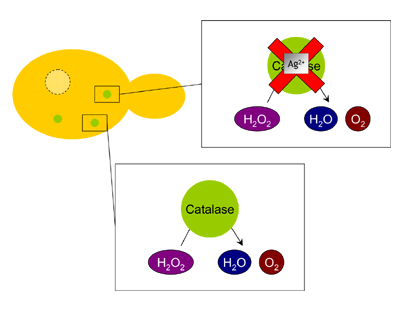
| MadSci Network: Biochemistry |
Well, there is no doubt that silver ions are quite toxic to microbes. Silver tends to bind very tightly to proteins and causes them to agglutinate. As for the catalase part of the question, it gets a little tricky. Catalase is a very widely spread enzyme throughout biology. Normal metabolism created a great deal of highly reactive oxygen molecules, including the ones present in hydrogen peroxide (H2O2). If your mom has ever put peroxide on a cut to kill of bacteria, you¡¦ve seen it in action. If the peroxide were allowed to exist in the cell, it would decompose to water and an oxygen radical (which is one half of oxygen gas), which can do some serious damage to cellular molecules; for instance, hydrogen peroxide is very damaging to DNA, and has been used as a bacterial mutagen for some time.
I am sure this is all review for you, Louise, so let me get to my point. While it is possible that the silver ions from the silver nitrate is killing the yeast, thus inhibiting the reaction, I would suggest that the silver ions are actually deactivating the catalase enzyme. Like I said before, silver ions tend to bind tightly to proteins and catalase is definitely a protein. If the silver ions noncompetitively inhibit the protein, then it can't catalyze the H2O2 (l) „³ H2O (l) + O2 (g) reaction. If the silver ions were destroying the yeast when you added it, then the yeast would no longer be able to ferment sugar into ethanol, and so the ethanol wouldn't be a factor anyway.
Also, if yeast has access to lots of oxygen (if the culture of yeast is being shaken or otherwise aerated) they tend not to produce much alcohol at all; so if the yeast cells in your reaction have lots of air then the impact of ethanol on your experiment should be minimized.
I searched for some sort of literature to support this theory, but I couldn't find anything that directly supported your hypothesis. I did find something kind of interesting, though. Several scientists have found that catalase actually plays a role in the breakdown of ethanol to a less poisonous chemical, acetylaldehyde. If this is true, then it would suggest that ethanol might competitively inhibit the catalysis of hydrogen peroxide into oxygen and water. I wish I could offer you more on that front.

To test out these hypotheses, I suggest that you look at how the catalase performs if you add a little pure ethanol to the reaction (not too much, not enough to kill the yeast) without any silver nitrate (you may need to play around with the concentrations of ethanol, but 5% v/v ethanol should be okay for a short time). If you are correct, and the ethanol is directly inhibiting the reaction, then you shouldn't see any gas formation if you add alcohol. You might also try using other metal cations that are less toxic to yeast; copper ions come to mind.
Best of luck to you!
Billy.
I have included some links here at the bottom for some background. Remember that while Wikipedia is a useful reference for background, it isn't peer reviewed and probably shouldn't be used as a primary source.
Wikipedia article: Catalase. http://en.wikipedia.org/wiki/Catalase
Aragon CM, Rogan F, Amit Z. Ethanol metabolism in rat brain homogenates by catalase-H2O2 system. Biochemical Pharmacology. 1992. 44(1). 93-8.
Try the links in the MadSci Library for more information on Biochemistry.